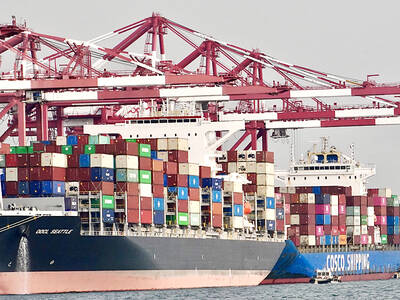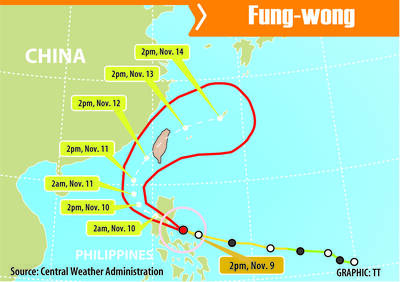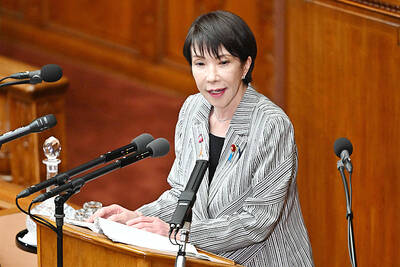The plot is sinister: Officials in Washington conspire to keep the dollar low and force Japanese authorities to intervene in the exchange market to buy the US currency -- not to save vulnerable Japanese exporters from the dangers of a high yen, but to keep the American economy from sliding.
This story line from a top selling comic book in Japan is entertaining and delightfully implausible. Nonetheless, it highlights growing fears here over currency fluctuations.

PHOTO: AP
There's little doubt that if the yen rises too much against the dollar, Japan's fragile export-driven recovery could sputter. Prices for Japanese products abroad would soar and earnings of major companies would plunge.
It's true that Japanese authorities have been dipping into the market for months. They have been spending a fortune buying and bolstering the value of the dollar while keeping the yen lower.
Now that dry economic reality has been turned inside out to become improbable fictional fodder for fans of Golgo 13 -- a "manga" action hero serial that's featured in the weekly Big Comic magazine.
Manga is a style of comic wildly popular in Japan among adults as well as children. The main character of Golgo 13 is a macho sniper-assassin, whose weekly illustrated exploits reflect the big social, political and financial changes on the world scene.
In the latest three-part series he's caught up in the center of a dramatic battle between the yen and dollar.
In the real world, analysts say there's no doubt Japan's shopping spree for dollars is helping the US economy.
"It's keeping US interest rates low and helping push up American share prices," says Mamoru Yamazaki, economist at Barclays Capital Japan in Tokyo.
But Yamazaki believes the intervention campaign has been excessive, fueled by exaggerated fears about a surging yen among Japanese officials and media.
"Sometimes a strong yen can be a good thing, like from a consumer's point of view," he said, referring to how a strong yen would push down import prices. "Excessive intervention is distorting the market."
The Japanese authorities spent a record ¥20 trillion (US$182 billion) to intervene in the currency market last year to curb the dollar's slide. They spent about ¥10 trillion (US$91 billion) in the first two months of this year alone.
Even so, the dollar has fallen more than 10 percent from last year to ?105 levels in February but has recovered lately to above 110 yen. All the while, Japan has been aggressively snatching up US Treasury bonds to keep their currency from getting too strong.
Japanese officials continue to brush aside speculation that interventions may be finally ebbing.
The dollar fell in Tokyo early yesterday amid continued speculation that Japan would ease up on its interventions. The greenback bought ?108.84 at 11am yesterday, down ?0.78 from late Tuesday in Tokyo but above the ?108.78 it bought in New York later that day.
It's hardly the dialogue of an action hero. But the creators of Golgo 13 have spiced things up.
In it high-profile Washington figures, including one apparently inspired by National Security Adviser Condoleezza Rice, are depicted as intensely worried about the dollar's possible plunge.
An overly weak dollar will not only set off a job exodus to China and India but will cause capital to flee from America, they fret.
The story suggests that the US has concocted a diabolical trap to force Tokyo to cough up a massive amount of cash to finance ballooning US deficits while preventing a crash in US Treasuries.

The Central Weather Administration (CWA) yesterday said it expected to issue a sea warning for Typhoon Fung-Wong tomorrow, which it said would possibly make landfall near central Taiwan. As of 2am yesterday, Fung-Wong was about 1,760km southeast of Oluanpi (鵝鑾鼻), Taiwan’s southernmost point, moving west-northwest at 26kph. It is forecast to reach Luzon in the northern Philippines by tomorrow, the CWA said. After entering the South China Sea, Typhoon Fung-Wong is likely to turn northward toward Taiwan, CWA forecaster Chang Chun-yao (張峻堯) said, adding that it would likely make landfall near central Taiwan. The CWA expects to issue a land

Taiwan’s exports soared to an all-time high of US$61.8 billion last month, surging 49.7 percent from a year earlier, as the global frenzy for artificial intelligence (AI) applications and new consumer electronics powered shipments of high-tech goods, the Ministry of Finance said yesterday. It was the first time exports had exceeded the US$60 billion mark, fueled by the global boom in AI development that has significantly boosted Taiwanese companies across the international supply chain, Department of Statistics Director-General Beatrice Tsai (蔡美娜) told a media briefing. “There is a consensus among major AI players that the upcycle is still in its early stage,”

The Central Weather Administration (CWA) yesterday said it is expected to issue a sea warning for Typhoon Fung-wong this afternoon and a land warning tomorrow. As of 1pm, the storm was about 1,070km southeast of Oluanpi (鵝鑾鼻), Taiwan’s southernmost point, and was moving west-northwest at 28 to 32kph, according to CWA data. The storm had a radius of 250km, with maximum sustained winds of 173kph and gusts reaching 209kph, the CWA added. The storm is forecast to pass near Luzon in the Philippines before entering the South China Sea and potentially turning northward toward Taiwan, the CWA said. CWA forecaster Chang Chun-yao (張峻堯) said

Japanese Prime Minister Sanae Takaichi yesterday said that China using armed force against Taiwan could constitute a "survival-threatening situation" for Japan, allowing the country to mobilize the Japanese armed forces under its security laws. Takaichi made the remarks during a parliamentary session while responding to a question about whether a "Taiwan contingency" involving a Chinese naval blockade would qualify as a "survival-threatening situation" for Japan, according to a report by Japan’s Asahi Shimbun. "If warships are used and other armed actions are involved, I believe this could constitute a survival-threatening situation," Takaichi was quoted as saying in the report. Under Japan’s security legislation,